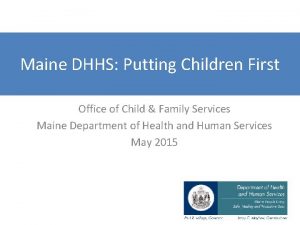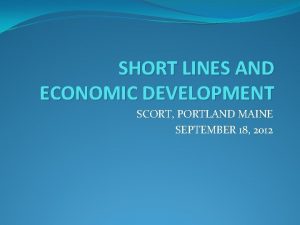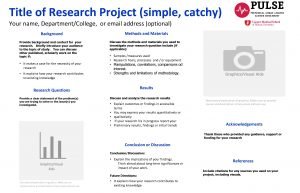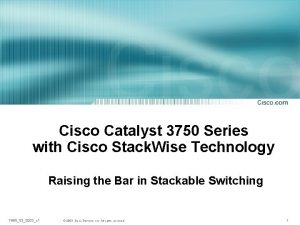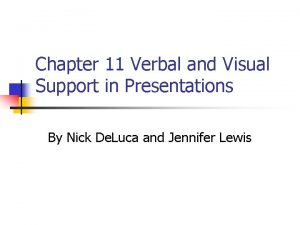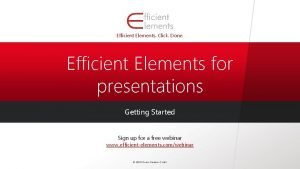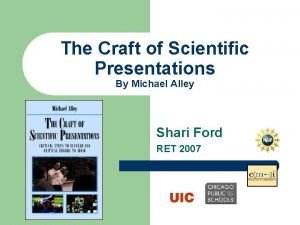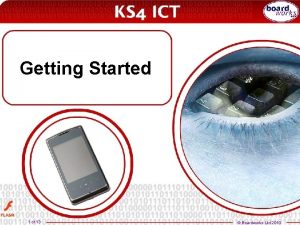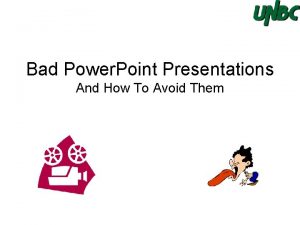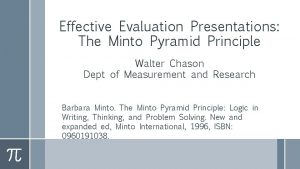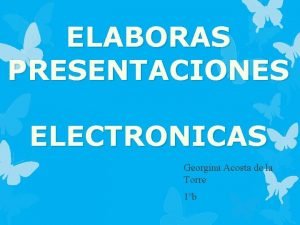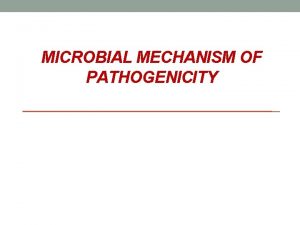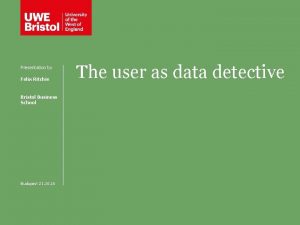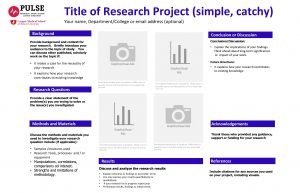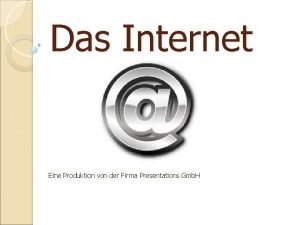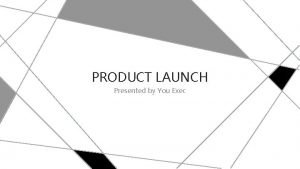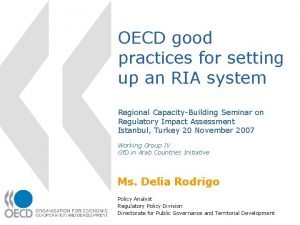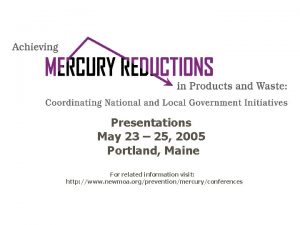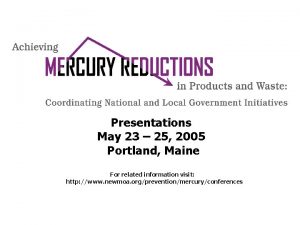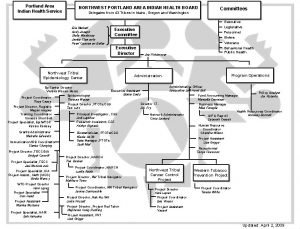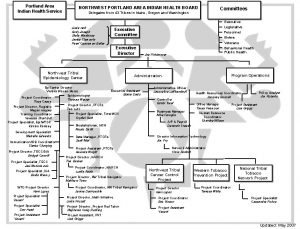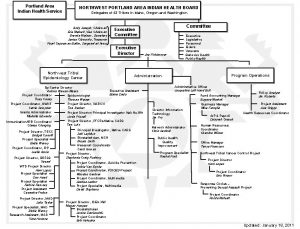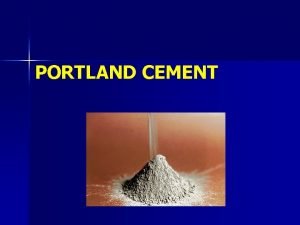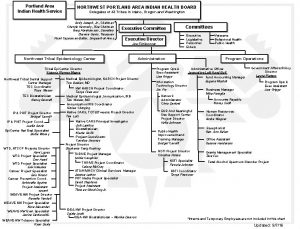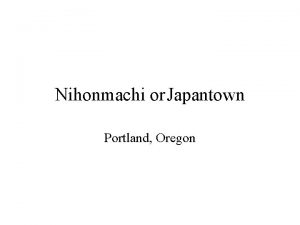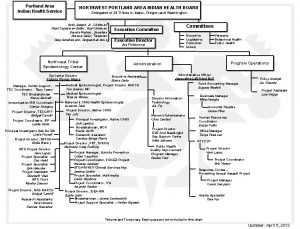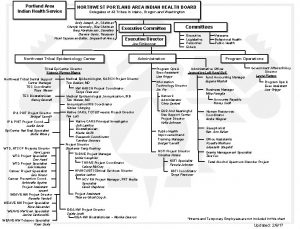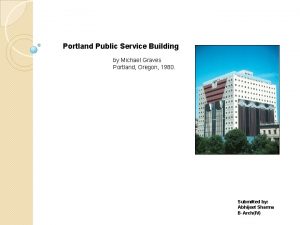Presentations May 23 25 2005 Portland Maine For








































































- Slides: 72

Presentations May 23 – 25, 2005 Portland, Maine For related information visit: http: //www. newmoa. org/prevention/mercury/conferences

UNEP’s Global Mercury Program By Charles French, U. S. EPA May 23, 2005 Portland, Maine

Mercury Pollution: a Global Issue n n n Mercury is toxic, persistent, and bioaccumulates in food chains Mercury is released from various sources throughout the world These releases can be transported great distances through air and oceans, easily crossing national borders, cycling globally Even nations with minimal mercury releases, and areas remote from industrial activity (such as the Arctic) are adversely affected Current releases add to the “global pool”…. .

GLOBAL MERCURY CYCLE Most mercury entering environment is due to emissions to air, but mercury is also released to water and land from various sources Courtesy of Rita Schoeny U. S. EPA. Adapted from U. S. Dept. of Interior’s Report on Hg in the Florida Everglades

Many humans/wildlife across the globe may be at risk • Largely due to consumption of fish; • Also due to other sources of exposure (such as artisanal mining and other occupations, cosmetics, spills, ritualistic uses, etc…) Artisinal gold mining/panning in Lao PDR - UNIDO photo

Anthropogenic Air Emissions of Mercury by Region in 1990 and 2000 1990 Africa 9% Africa Asia 38% Asia 18% 52% South America 3% South America 4% North America 14% North America 9% Europe 33% Total: 1, 881 metric tons/yr Australia Europe 6% 11% Total: 2, 269 metric tons/yr Note: Significant emissions also occur due to natural sources, and re-emissions from historic anthropogenic sources. Based on Pacyna, J. , Munthe J. , Presentation at Workshop on Mercury: Brussels, March 29 -30, 2004

Anthropogenic Air Emissions of Mercury by Industrial Sector in 1995 Non-ferrous metal production 170 (7%) Pig iron and steel production 30 (1%) • Estimates are uncertain; most countries do not have Hg inventories Cement production 130 (5%) Coal/Fuel combustion 1470 (62%) Waste disposal 110 (5%) Artisanal gold mining 300 (13%) Chlor-alkali 172 (7%) Total: 2, 382 metric tons Source: Estimates derived from data in the 2002 UNEP Global Mercury Assessment

EPA Model of Contribution of U. S. vs. International Sources to Mercury Deposition • Based on modeling about half of U. S. mercury deposition is from U. S. anthropogenic sources and half is from other sources • Domestic sources dominate deposition for large part of Eastern U. S. • Global sources are dominant in the Western U. S. Source: REMSAD model

Relative Contribution of Domestic vs. International Sources to fish mercury levels U. S. Domestic Emissions International Emissions (Global Pool) Deposition Farm Fish Waterways Freshwater Fish (East) Atlantic Coastal/ Gulf Fish Increasing Domestic Percentage Contribution Freshwater Fish (West) Other Marine Fish Increasing International Percentage Contribution

United Nations Environment Program (UNEP) n n UNEP, in collaboration with other organizations, has been pivotal in raising global awareness of mercury pollution The mandates, priorities, and scope of work for UNEP are largely determined by the UNEP Governing Council (GC), which holds a general session every 2 years

UNEP Global Mercury Assessment (GMA) Report – Completed in 2002 by UNEP Working Group – Initiated by UNEP GC in February 2001 (during 21 st Session) – Extensive info on global mercury pollution, including sources of releases, uses in products and processes, fate & transport, toxicity, exposures, and prevention/control measures

UNEP GC Decision in February 2003 (22 nd Session) n n n Concluded there is sufficient evidence of significant global adverse impacts to warrant further international action Decided national, regional and global actions should be initiated ASAP Urged all countries to adopt goals and take actions to identify exposed populations & reduce releases Requested UNEP to initiate technical assistance and capacity building activities Established the UNEP Mercury Program

UNEP Mercury Program 2003/05 n Hosted 7 Regional Awareness Raising Workshops n n Drafting guidance materials to help countries: n n In Argentina, Lebanon, Senegal, South Africa, Thailand, Ukraine, and Trinidad and Tobago Develop Inventories of Mercury Releases Identify Populations at Risk Others Establish and maintain an information Clearinghouse

UNEP GC Decision in February 2005 (the 23 rd Session) n Requests UNEP to: n n n Further develop the Mercury Program Prepare a report summarizing supply, trade and demand information on mercury, including in artisanal mining Encourages Governments to: n “promote and improve evaluation and risk communication methods…. . ”

UNEP GC Decision in February 2005 (23 rd Session) n Requests Governments, private sector, etc. . . to take immediate actions to reduce risks posed by mercury in products and processes n n n Considering application and sharing of Best Available Techniques to reduce emissions… Action on reducing risk of exposure related to mercury in products (such as batteries) and processes (such as chlor-alkali plants) Consider curbing primary mercury production

UNEP GC Decision in February 2005 (23 rd Session) n n Urges Governments, IGOs, NGOs, and private sector to develop & implement partnerships… as one approach to reducing the risks due to the release of mercury to environment Requests UNEP to: n n Invite Governments to identify priority partnership areas ASAP, with the goal of identifying a set of pilot partnerships by September 1, 2005 Report on progress of the partnerships to GC at the 24 th Session (February 2007)

UNEP GC Decision in February 2005 (23 rd Session) n n Requests UNEP to facilitate work among various stakeholders to: n Improve understanding of sources, fate, transport n Promote development of inventories n Promote development of environmentally sound disposal and remediation practices n To increase awareness of environmentally sound recycling practices Decides to assess at next Session (February 2007) the need for further action, considering the full range of options, including the possibility of a legally binding instrument, partnerships and other actions

U. S. Government Support n n U. S. Government provides significant support to the Program, including financial, technical, staff time, etc… Largest Donor: n $1. 3 million in 2003 -04 n Plan to contribute over $1. 5 million in 2005

U. S. Government Involvement n Pleased with GC decision, and especially interested in establishing partnerships in the following areas: n n n Chlor-alkali production Products Artisanal, small-scale mining Coal-fired power facilities Research on Fate, Transport, Global Cycling Believe Partnerships will strengthen existing Program, and that progress can be made in short-term to reduce uses and releases

U. S. Involvement Partnerships n Each partnership will be unique because of the variation of sources, different issues, etc…, but in general, partnerships could include some or all of the following: n n n n Sharing information about best management practices and appropriate technologies Demonstration projects Leveraging Resources Data collection and reporting Training and Workshops Outreach and Education Other activities with an aim to reduce uses and releases, etc…

Partnerships n n Stakeholders are invited to participate A “partner is an entity who indicates a willingness to contribute time, resources, or expertise to implement the partnership…”

U. S. Hosting Informal Consultations to Further Discuss & Develop Partnerships n May 25, from 2: 00 to 5: 00, at the Eastland Park Hotel, in Portland, Maine n Mercury Reduction in Products n n Mercury Reduction in Chlor-alkali Sector n n Contact: Denise Wright (U. S. EPA) Contact: Angela Bandemehr (U. S. EPA) June 15, from 1: 00 to 5: 30, at World Bank, in Washington D. C. n Mercury Management in Artisanal and Small-scale Gold Mining n Contact: Marianne Bailey (U. S. EPA)

For More Information n See UNEP Mercury website: n www. chem. unep. ch/mercury/

Presentations May 23 – 25, 2005 Portland, Maine

Mercury Product Life-Cycle Tool: Uses and Results Alexis Cain, US Environmental Protection Agency, Region 5 Achieving Mercury Reductions in Products and Wastes, Portland, ME, May 23, 2005

Questions n Are Products (Still) Important Sources of Mercury to the Environment? n n n Incinerators have been controlled Mercury thermometers have become rare Which Products Contribute the Most? Which Pathways Contribute the Most? Which Interventions Will Reduce Mercury the Most?

Mercury Product Life-Cycle Release Estimation Project n n n Minnesota PCA (Ed Swain)/Barr Engineering (Carol Andrews, Bruce Monson)– estimates for MN in 2001– Used to improve MPCA mercury emissions inventories Wisconsin DNR/Barr/Dane County– adapted for WI in 2003 -2004 -5; EPA Region 5, WDNR (Randy Case), Dane Co. (John Reindl), Barr (Cliff Twaroski, Sarah Disch) develop national estimates

Life-Cycle Mercury Flow Approach n n n Mass Balance Spreadsheets Distribution Factors Release Factors Estimated releases to air, water, land in 1990, 2005 -10 Mercury used in products is released, recycled, or maintained in inventory

Products Covered n n Dental amalgam Fluorescent lamps, other lamps Bulk liquid mercury Switches and relays n n n Measurement and Control Devices n n n Auto switches Thermostats Thermometers Batteries– a back of the envelope analysis Did not evaluate chemicals, fungicides

Air Emissions, by Product

Air Emissions, by Pathway

Emissions by Pathway: 2005 Total: 24. 3 metric tons

Selected 1999 NEI* Emissions Compared with Model (2000) NEI Model 5. 9 8. 2 ? 2. 7 Refuse Systems 1. 9 ? Lamp Breakage 1. 4 1. 6 ? 4. 6 Sewerage Systems 1. 6 Mercury Recycling 0. 2 0. 6 12. 4 10. 9 Zinc Production ? 2. 0 Metal Shredders ? 1. 8 Auto Fluff ? 0. 4 Medical/Municipal Incinerators Burn Barrels All Product Breakage Iron and Steel Furnaces* NEI: EPA’s National Emissions Inventory. Steel furnace estimate from regulation development for foundries and electric arc furnaces.

Iron and Steel Recycling n n n Less decrease than in most other categories Not just autos– autos account for under 1/2 of steel furnace emissions (high uncertainty) Not just steel furnaces– zinc production, shredders, auto fluff

Solid Waste Management System n n n Emissions declining rapidly Big impacts from battery P 2; incinerator regulations Emissions could be significant for: n n n Burn barrels Product breakage during use, transport to disposal sites High uncertainty

Dental Amalgam n n n Significant water releases (495 kg in 2000) >50% Air releases from sludge incineration and land application, dental office vacuum system, cremation, exhaled air (high uncertainty) Potential BMP/Separator impact?

Evaluation of Potential Control Options: Dental Amalgam, 2005 Water Air BMP Status quo, no separators 426 6, 428 100% BMP adherence, zero separators 100% adoption of BMPs and 95%effective separators 327 5, 974 99 5, 423 In kg. Assumes that WWTPs are equally effective at removing dental amalgam and other mercury from sewage.

Evaluation of Potential Control Options—Air Emissions Impact n Auto switches, 2005 n n 0 switch removal– 5, 050 kg emissions 20% removal– 4, 090 kg 80% recycling— 1, 211 kg Fluorescent lamps, 2005 n n 25% lamp recycling— 1, 142 kg emissions 75% lamp recycling– 599 kg emissions

Conclusions n Products Are Still Important Sources of Mercury to the Environment n n n Releases reduced significantly Important reduction opportunities in iron and steel production/recycling; dental, lamps Model provides opportunity to better understand release pathways and to test impact of potential control strategies Quantification is rough—many uncertainties More detail on the model: Wednesday, 5/25

Questions? n Alexis Cain USEPA-Region 5 (312) 886 -7018 cain. alexis@epa. gov

Presentations May 23 – 25, 2005 Portland, Maine

Mercury Pollution in the Northeast: Sources, Impacts and Role of Mercury Products C. Mark Smith, Ph. D MS Massachusetts Department of Environmental Protection/ Co. Chair NEG-ECP Mercury Task Force

Credits • Inventory: Margaret Round, NESCAUM; state air program staff • Deposition modeling: John Graham; Jung-Hun Woo; Emily Savelli (NESCAUM) • Deposition monitoring: Gerald Keeler (U. Michigan); Margaret Round (NESCAUM); Thomas Mc. Grath and Air Assessment Branch staff (MADEP) • Fish monitoring: Michael Hutcheson; Carol Rowan West, Jane Rose; Kenneth Hulme; Barbara Eddy; Oscar Pancorbo; Chi-ying Hsieh; Robert Maietta; Gregory De. Cesare (MADEP) Normandeau Associates staff. • Costs: Praveen Amar (NESCAUM); James Hammitt (HCRA); Glenn Rice (EPA)

Part A: Mercury Impacts in the Northeast

1. Many Waterbodies Impacted In MA > 60% of lakes tested; statewide advisory; over 100 waterbodies with specific advisories. C. Mark Smith Ph. D, MS. 2003.

2. Many Children at Risk Based on CDC data 84, 000 newborns each year at risk in the northeast C. Mark Smith Ph. D, MS. 2003.

3. Wildlife At Risk Fish eating birds, even some songbirds Fish Eating Mammals C. Mark Smith Ph. D, MS. 2003.

4. Mercury Health Costs Significant ØMt. Sinai School of Medicine Mercury Health Cost Study (2005) ØHarvard Center for Risk Analysis NESCAUM Mercury Reduction Health Benefit Study (2005)

Mt. Sinai School of Medicine Mercury Health Cost Study (2005) • Economic costs from mercury exposure from all sources/ utility emissions • Health effects considered: • Neurotoxicity (decreased IQ) in children • Other health/ environmental impacts not considered • Anthropogenic mercury costs for all sources: $2, 200, 000 – $43, 800, 000 per year. – NE costs: $293, 000 – $5, 835, 000 per year • Costs per pound of mercury pollution (based on utility emissions): $13, 000 (range: $1, 000 $66, 000)

Harvard Center for Risk Analysis NESCAUM Mercury Health Benefit Study (2005) • Health benefits associated from 68, 000 lb. reduction in emissions attributable to EPA’s utility rule. • Health effects considered: • Neurotoxicity in children (IQ); cardiovascular impacts in adults • Other health effects/ environmental costs not considered. • Benefit estimate: – $100, 000 to $5, 000, 000 per year; – $1, 500 to $74, 000 per pound of mercury emissions prevented.

Part B: Mercury Deposition in the NE- Origins and Progress Regional deposition modeling and monitoring. Preliminary results and qualitative comparisons.

Northeast Total Deposition (1998 NE Regional Mercury Study) Yellow= 10 -30 ug/m 2 Lt red= 30 -100 Red= >100 Regional Langrangian Model of Air Pollution (RELMAP) output

Northeast Total Deposition (preliminary results, 2005 NESCAUM) Regional Modeling System for Aerosols and Deposition (REMSAD) output.

Allocation of Modeled Deposition to Eight Northeast States 1998 study 2005 study Sources Inside Region 47% 21% U. S. Sources Outside Region 30% 23% 49% Global Reservoir

Relative Contribution of Source Categories and Region to Modeled Hg Deposition in the NE States (1998)

Relative Contribution of Source Categories and Region to Modeled Hg Deposition in the Northeast States (2003)

Part C: Taking Action To Address “Hotspots”Environmental Results NE MA Study Area

Targeted Study of Regional High Deposition Area • NE MA: highest predicted Hg deposition 1998 Regional Mercury Study – Historical emissions: 3 MSWCs; 1 large MWI; several smaller MWIs; SSI; utilities – Controls= high delta in inputs • “Early-responder” hypothesis/ public health concerns • Components: emissions/ deposition/ biota/ sediments

Fish Mercury Concentrations in Northeastern MA Based on Public Health Risk Criteria

Estimated MA Statewide and High Dep. Area Mercury Emissions MA High Dep Baseline 2002 Estimated reduction (lbs/year) 2003 (lbs/year) 8, 600 2, 540 70% 4, 100 540 87%

Modeled vs Measured Mercury Wet Deposition in MA 1998 Modeled Wet Deposition (ug/m 2) 2005 Modeled Wet Deposition (ug/m 2) 2002 Measured Wet Deposition (ug/m 2) Quabbin 5 -15 < 10 8. 8 N. Andover >50 < 10 10. 7

Hg Source Contributions: N. Andover (2002 -2003)

Part D: Northeast States Mercury Emission Inventory - 60% Reduction (1998 vs. 2003)

Regional vs National Emissions 1996 EI NESCAUM 17. 6 TPY 124. 3 TPY 2003 EI NESCAUM 7. 0 TPY

Emissions - by States and Sectors 100% 1996 NESCAUM Emission Inventory 2003 NESCAUM Emission Inventory 10. 0 100% 10. 0 80% 8. 0 60% 6. 0 40% 4. 0 20% 2. 0 0% 0. 0 NY NJ MA CT NH EGU RI ME NY VT MWC+MWI SSI NJ Other Emissions reduced significantly after controls put in place MA CT NH Amount(TPY) RI ME VT

Mercury Reductions in New England E. Canadian Provinces

Part E: Closing The Loop. Mercury P 2

Estimated Health Benefits of Mercury Pollution Control Ø $1, 500 to $74, 000 per pound of mercury emissions prevented Harvard Center for Risk Analysis NESCAUM Mercury Reduction Health Benefit Study (2005) Ø $13, 000 (range: $1, 000 - $66, 000) per pound of mercury emissions prevented Mt. Sinai School of Medicine Mercury Health Cost Study (2005) Costs

Cost Estimates of Mercury Pollution Prevention Programs • Car Switch Collection Programs: $1, 900 per pound of mercury collected (range= $1, 100 (at $3 per switch, low-end estimate) to $3, 800 (at $10 per switch, a maximum cost estimate). (Based on NJDEP report, 2004) • Thermometer exchange programs: $2, 500$3, 000 per pound of mercury collected (MA EOEA and Vt. programs) • Community P 2 programs: $840 per pound of mercury collected (MA MSWC SSP, 2002) • School cleanout programs: $230 -$500 per pound of mercury collected (MADEP program costs)

Cost Estimates of Mercury Pollution Control Programs • Amalgam Separators: $2, 600 per pound of mercury disposal to wastewater prevented (range= $1, 900$3, 800) (MA/MDS, 2004 data) • Coal-fired Utility Regulations: $2, 700$11, 700 per pound of mercury air pollution prevented. (MADEP, 2002 report)

Conclusions • Mercury impacts including $ costs substantial in the NE • State actions have effectively reduced regional emissions • Preliminary data: regional deposition likely reduced

Conclusions • Out-of-region sources very significant – Cannot achieve TMDL objectives without substantial reductions in out-of-region sources (>90% for some waterbodies) • Mercury–added products contribute significantly to remaining releases and deposition in NE • P 2 programs appear cost effective
 Dhhs portland maine
Dhhs portland maine Scortportland
Scortportland Walters restaurant portland maine
Walters restaurant portland maine Hard rock cafe portland maine
Hard rock cafe portland maine Ch robinson queretaro
Ch robinson queretaro Research project name
Research project name To maintain audience interest in a multimedia presentation
To maintain audience interest in a multimedia presentation Cisco 3750 stacking
Cisco 3750 stacking Who is lazarus in the most dangerous game
Who is lazarus in the most dangerous game What are the three major types of verbal support
What are the three major types of verbal support Roof ppt presentations
Roof ppt presentations Efficient elements license key
Efficient elements license key The craft of scientific presentations
The craft of scientific presentations Boardworks presentations
Boardworks presentations Kayaking merit badge powerpoint
Kayaking merit badge powerpoint Slidetodoc.com
Slidetodoc.com Bad powerpoint presentations examples
Bad powerpoint presentations examples Note card for presentation
Note card for presentation Tok presentations
Tok presentations Https://creativemarket.com/
Https://creativemarket.com/ Titles for mental health presentations
Titles for mental health presentations You exec presentation
You exec presentation Scqa structure
Scqa structure Customer service presentations
Customer service presentations Ventajas y desventajas de corel presentations
Ventajas y desventajas de corel presentations Really bad powerpoint presentations
Really bad powerpoint presentations The end pictures for presentations
The end pictures for presentations Business presentations bristol
Business presentations bristol World's worst presentation
World's worst presentation Horse topics for presentations
Horse topics for presentations Worst ppt slide ever
Worst ppt slide ever Research project title
Research project title Internet presentations
Internet presentations Designing and delivering oral and online presentation
Designing and delivering oral and online presentation Youexec
Youexec Useful phrases for presentations
Useful phrases for presentations Ria seminar presentations
Ria seminar presentations Types of oral presentations
Types of oral presentations Hci design patterns
Hci design patterns Rutin för avvikelsehantering
Rutin för avvikelsehantering Myndigheten för delaktighet
Myndigheten för delaktighet Presentera för publik crossboss
Presentera för publik crossboss Treserva lathund
Treserva lathund Tack för att ni lyssnade
Tack för att ni lyssnade Debattartikel mall
Debattartikel mall Kung som dog 1611
Kung som dog 1611 Tobinskatten för och nackdelar
Tobinskatten för och nackdelar Tack för att ni lyssnade bild
Tack för att ni lyssnade bild Mall för referat
Mall för referat Atmosfr
Atmosfr Programskede byggprocessen
Programskede byggprocessen Brunn karttecken
Brunn karttecken Var finns arvsanlagen
Var finns arvsanlagen Rbk-mätning
Rbk-mätning Tryck formel
Tryck formel Elektronik för barn
Elektronik för barn Densitet vatten
Densitet vatten Tack för att ni har lyssnat
Tack för att ni har lyssnat Smärtskolan kunskap för livet
Smärtskolan kunskap för livet Frgar
Frgar Argument för teckenspråk som minoritetsspråk
Argument för teckenspråk som minoritetsspråk Mjälthilus
Mjälthilus Samlade siffror för tryck
Samlade siffror för tryck Autokratiskt ledarskap
Autokratiskt ledarskap Ekologiskt fotavtryck
Ekologiskt fotavtryck Särskild löneskatt för pensionskostnader
Särskild löneskatt för pensionskostnader Blomman för dagen drog
Blomman för dagen drog Redogör för vad psykologi är
Redogör för vad psykologi är Borra hål för knoppar
Borra hål för knoppar Bris för vuxna
Bris för vuxna Mat för idrottare
Mat för idrottare Gumman cirkel
Gumman cirkel Svenskt ramverk för digital samverkan
Svenskt ramverk för digital samverkan
